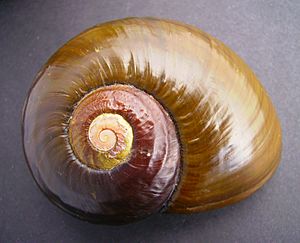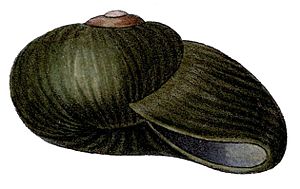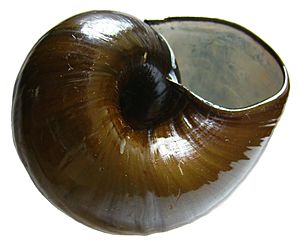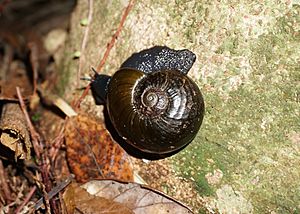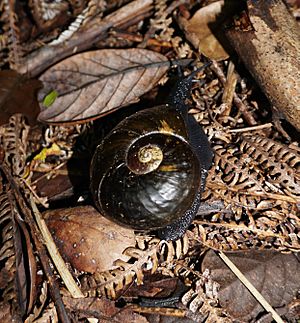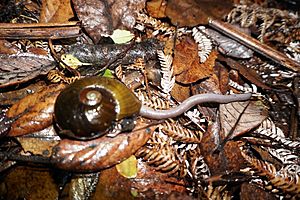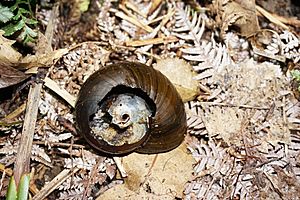Paryphanta busbyi facts for kids
Quick facts for kids Paryphanta busbyi |
|
|---|---|
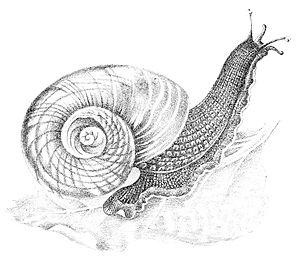 |
|
| A drawing of a live individual of Paryphanta busbyi. | |
| Conservation status | |
| Scientific classification | |
| Kingdom: | |
| Phylum: | |
| Class: | |
| (unranked): |
clade Heterobranchia clade Euthyneura
clade Panpulmonata clade Eupulmonata clade Stylommatophora informal group Sigmurethra |
| Superfamily: |
Rhytidoidea
|
| Family: |
Rhytididae
|
| Genus: |
Paryphanta
|
| Species: |
P. busbyi
|
| Binomial name | |
| Paryphanta busbyi (Gray, 1840)
|
|
| Synonyms | |
|
|
Paryphanta busbyi is a very large snail that lives on land. It's a special type of snail that breathes air and belongs to a family called Rhytididae. These snails are predators, meaning they hunt and eat other small creatures.
Contents
Where This Snail Lives
The Paryphanta busbyi snail lives in the northern parts of North Island, New Zealand. You can find them in places like Kaitaia, Hokianga, Bay of Islands, and Whangārei. Their natural home stretches south to Warkworth.
These snails mostly live where kauri forests grow. They have also been found in new areas like Little Huia and Waiuku. The first snail of this type ever studied came from New Zealand. Its original sample is kept in the Natural History Museum, London.
What Its Shell Looks Like
The shell of Paryphanta busbyi is big and wide. It is somewhat flat and shaped like a disc. The shell is not see-through and looks shiny. It is usually a deep green color, sometimes with dark green stripes.
The shell has special patterns on it. The first part of the shell has slanted lines. The next two parts feel rough. On the newer parts of the shell, you can see spiral lines. These lines start by pointing up, then become spirals on the last part of the shell.
The shell also has growth lines that are easy to see. The whole surface of the shell has tiny, fine lines that cross each other. The outer layer of the shell, called the periostracum, is thick and shiny. It hangs over the edge of the opening.
The top of the shell is flat or slightly raised. The shell has about 4½ turns, which grow quickly. The last turn is very large and rounded. The opening of the shell is shiny blue inside. It is shaped like a half-moon. The edge of the opening is simple and curves inward.
The shell of this snail is very special. It has a thick outer layer (periostracum) but a very thin calcium layer. If the shell gets too dry, the outer layer shrinks. This can cause the shell to break into many pieces.
- The shell can be 60 to 79 millimeters wide.
- It can be 33 to 44 millimeters tall.
- The shell of a baby snail is about 10 millimeters wide and 9 millimeters tall.
How the Snail's Body Works
The snail's body is bluish-black. Its foot, which it uses to move, might be a bit lighter in color. The head and neck have rows of bumps. Other parts of the body have oval-shaped bumps that are not in neat rows.
The snail has a special part called a mantle. This mantle has a clear edge and a groove. Underneath the mantle, there is a flap that covers the breathing and waste openings.
Inside its mouth, the snail has a strong eating part called the buccal mass. It also has salivary glands that make spit. These glands are on top of the eating part. They help the snail digest its food. The snail's stomach is a simple, long sac.
The snail has a kidney that is shaped like a short tongue. It helps clean the snail's body. The snail also has a lung, which is how it breathes air.
Where and How This Snail Lives
These large snails live in litter on the ground. You can find them among plants and under logs in kauri forests. They also live in shrubland. Sometimes, they dig deep into soft soil. They can even be found in forests with non-native plants like pine trees.
Paryphanta busbyi snails are most active when the weather is cool and wet. They like high humidity and still air. This helps them find their prey. During dry weather, they are not active and hide in safe spots.
This snail is a predator. It eats earthworms, insects, and insect larvae. It also eats other snails, including snails from the Rhytida genus. Sometimes, it even eats other Paryphanta busbyi snails, which is called cannibalism. These snails might also live in trees, possibly in clusters of plants that grow on trees. They may find earthworms there.
Life Cycle
Paryphanta busbyi snails usually lay their eggs at the bottom of large trees. They lay them in groups of four to six eggs, hidden under dead leaves. The eggs are oval-shaped and white. They are about 10.5 to 14 millimeters long.
It takes about 7 years for a snail to grow to a shell width of 54 millimeters. The number of Paryphanta busbyi snails is lower compared to other similar snails like Powelliphanta.
Predators of the Snail
The native Māori people did not eat these snails.
However, other animals do eat Paryphanta busbyi snails. Their predators include rats, pigs, possums, hedgehogs, and birds. Rats and birds usually eat the young snails. Pigs eat snails of all sizes, including their eggs. Pigs also damage the places where these snails live.
Protecting This Snail
As early as 1913, people noticed that this snail was disappearing quickly. This was due to the destruction of its home, the kauri forests. Bush fires, rats, and pigs also caused problems. Today, the main threats are animals brought in by humans, and changes to their habitat.
This snail is protected by the Wildlife Act 1953 in New Zealand. It was once listed under CITES, which helps control trade of endangered species. However, it was removed because collecting these snails was not a big reason for their decline.
In 2009, the Paryphanta busbyi was listed as "nearly threatened" on the IUCN Red List. In 2002, it was called "Chronically Threatened - Gradual decline" in the New Zealand Threat Classification System lists. It was also a "third priority" threatened species. However, it is not in this category in the 2005 list.



